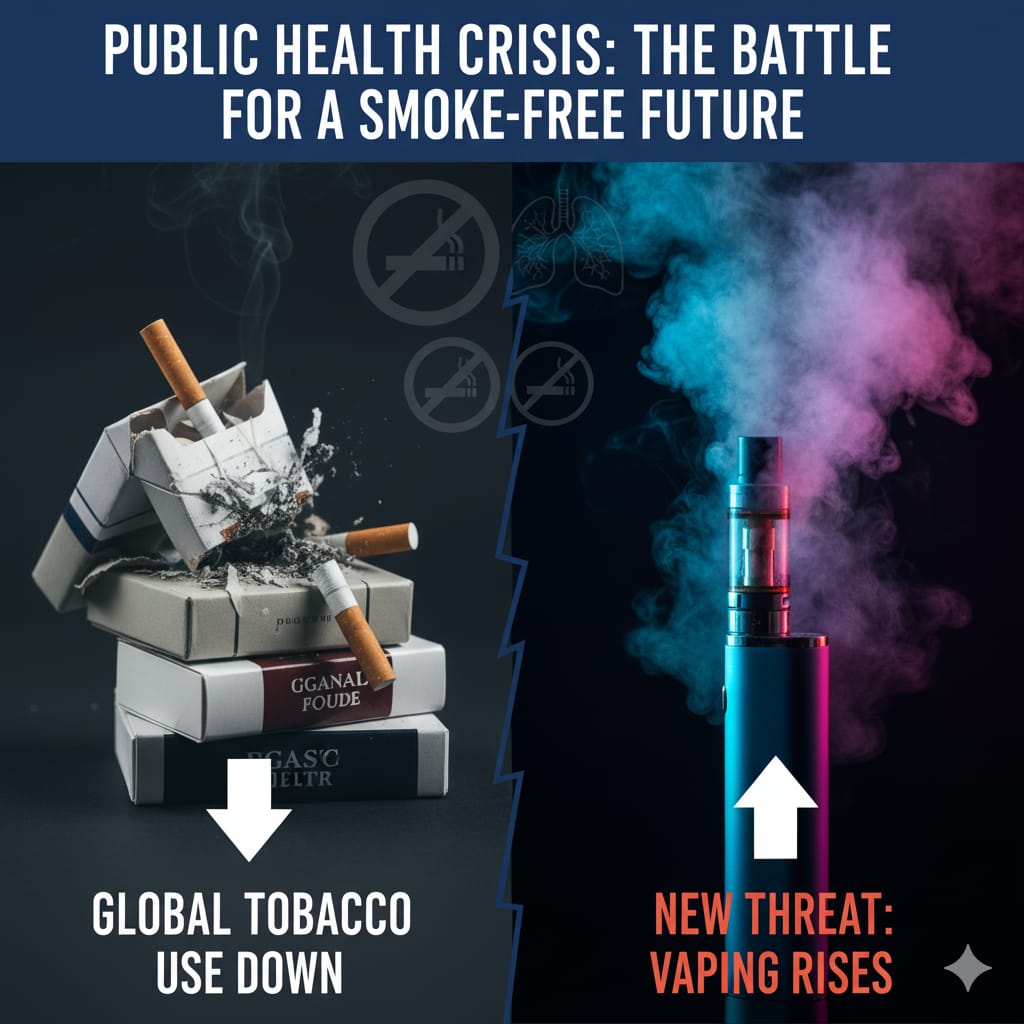
A historic shift is underway in global health. For the first time since comprehensive global tracking began, the world is witnessing a significant and sustained drop in the number of people consuming tobacco. According to recent World Health Organization (WHO) reports, stringent tobacco control measures and increased public awareness have pushed the global user count down by 120 million since 2010.
However, this public health victory is tempered by the uneven distribution of the decline and the alarming rise of nicotine alternatives like e-cigarettes. While the overall picture is improving, policymakers face a critical moment: celebrating success while simultaneously battling a powerful, emerging wave of addiction targeting younger generations.
The Global Picture: A Decline Driven by Policy
The overall trajectory of tobacco use provides a clear metric for the success of worldwide public health interventions. At the turn of the millennium in 2000, global tobacco users stood at a staggering 1.38 billion. By 2020, this figure had fallen to 1.30 billion, and projections suggest the number will drop further to 1.2 billion by 2024. This cumulative reduction of over 120 million users since 2010 is a monumental achievement, reflecting the impact of policies ranging from pictorial health warnings and marketing bans to increased taxation.
This downward trend has fundamentally altered global tobacco prevalence. In 2000, approximately 49.8% of the world's population used tobacco. By 2020, that figure was nearly halved to 23%. This transformation demonstrates that the coordinated efforts of governments and health organizations are effective in denormalizing smoking and helping millions quit.
Nevertheless, despite this progress, one stark statistic underscores the magnitude of the remaining challenge: globally, one in five adults still uses a tobacco product. The fight is far from over, requiring sustained vigilance and investment in proven cessation and prevention programs.
Uneven Declines and Regional Disparities
The global headline of declining use obscures significant regional and demographic disparities. The decline in tobacco consumption is not uniform, meaning the burden of associated diseases remains heavily concentrated in certain parts of the world.
While many Western nations have seen dramatic reductions, regions such as South-East Asia and the Western Pacific continue to grapple with high prevalence rates. Projected 2024 figures show South-East Asia with a regional prevalence of 24.1% and the Western Pacific at 23.4%. These areas often face unique challenges, including large populations, prevalent cultural acceptance, and sometimes less robust regulatory frameworks, making sustained control more difficult.
In contrast, the European region is projected to be around 18%, and the African region is notably lower at 14%. This variation demands tailored strategies. Success in one region cannot be replicated blindly; it must be adapted to local cultural, economic, and political realities.
The case of India highlights the massive scale of the domestic challenge, despite global trends. The country is home to approximately 243.5 million current tobacco users aged 15 and above. This sheer volume of users means that even small percentage declines translate into millions of lives saved, yet the health infrastructure remains strained by the massive ongoing impact of tobacco-related illness.
A New Global Threat
The greatest emerging threat to the decades-long progress in tobacco control comes in the form of nicotine and tobacco-adjacent products, particularly e-cigarettes. The industry has aggressively marketed these alternatives, often positioning them as harmless, sleek, or even healthy lifestyle accessories, directly targeting youth and adolescents.
The data reveals a deeply troubling picture: 100 million people globally are now estimated to be using vaping products. More critically, the use of these devices has infiltrated educational settings and youth culture. Globally, 15 million children aged 13 to 15 years are currently using e-cigarettes. This alarming statistic represents an entirely new generation being exposed to highly addictive nicotine products, potentially erasing the gains made through traditional anti-smoking campaigns.
Public health officials warn that the introduction of flavors, discreet devices, and online marketing bypasses the restrictions placed on conventional tobacco products. This strategy creates a new gateway to addiction, often leading to dual use of both traditional and electronic nicotine delivery systems. If left unchecked, this emerging threat risks sabotaging global public health efforts and creating a long-term addiction crisis among young adults.
Sustaining Momentum
The documented decline in global tobacco use is cause for cautious optimism, but it must serve as motivation, not a signal of victory. The current reality requires a dual approach: reinforcing successful control measures while immediately confronting the new threats.
To sustain the momentum of the global drop, countries must fully implement the WHO’s MPOWER measures, which focus on monitoring tobacco use, protecting people from smoke, offering help to quit, warning about dangers, enforcing bans on advertising, and raising taxes.
Furthermore, a specific, urgent focus must be placed on regulating e-cigarettes and vaping products. This requires:
- Closing Regulatory Loopholes: Treating e-cigarettes like tobacco products in terms of taxation, advertising bans, and age restrictions.
- Banning Flavors: Eliminating the appealing flavors that are primarily responsible for drawing in new, young users.
- Educational Initiatives: Launching targeted campaigns to counter industry narratives and educate youth and parents about the addiction risks associated with vaping.
The successful reduction of 120 million tobacco users over the last decade proves that a nicotine-free world is an achievable goal. However, success hinges on immediate action against the emerging threats that endanger the well-being of the next generation. The global community must prioritize the health of its citizens and ensure that the historic progress achieved does not become a historical footnote overshadowed by a new, avoidable public health crisis.





















